

Do you attend a non-US med school but want to do residency training in the US? Did you go to a Caribbean school and are worried about overcoming IMG discrimination? Are you overwhelmed by the jumble of acronyms, names, and details required in the process? Want actual data on what specialties are more “IMG Friendly”? (What? You don’t like advice from anonymous Redditors who never trained in the US?). Do you struggle to find credible information from other successful IMGs?
If you answered “yes” to any of those questions, you’ve come to the right place. Applications to get residency in the United States are competitive. Nearly 50% of all applicants are screened out. However, the numbers are bleaker for graduates of non-US medical schools. With the correct information, however, your path can be considerably smoother and faster.
Summary:
-
- An IMG is an International Medical Graduate.
- Average USMLE scores for matched IMGs are similar to that of matched US graduates.
- ECFMG certification is required for residency in the US.
- The ideal time to take USMLE exams is before applying to residency.
- Generating a list of “IMG-friendly” programs for ANY specialty is easy with the Residency Explorer Tool or FREIDA.
- J-1 and H1-B are the most common visa types for Non-US IMGs.
- And much more!
NOTE: This article is jam-packed with information. There are essential dates and practical advice. Plus, you can see cold, hard data on successful past residency applicants. I recommend that you bookmark this page. You can revisit it on your journey to residency training in the US.
Legal disclaimer: we are not lawyers. This post should not be considered legal advice. You should seek appropriate counsel for your situation, including if you are seeking a visa or other legal status.
Note: this article was updated in February 2025 with data from the 2022 Charting Outcomes in the Match for US Seniors and IMGs, as well as the 2020 NRMP Program Direct Survey.
Table of Contents
Definitions: What is an IMG?
Let’s start with some definitions.
IMG: International Medical Graduate
- You attended a medical school outside of the United States and Canada
IMGs consist of two sub-groups:
- US-IMGs: US Citizens or permanent residents who attended a “foreign” medical school. Example: someone born in the US, but went to a Caribbean medical school (a non-US school).
- Non-US IMGs: Non-US citizens or permanent residents who attended a “foreign” medical school. Example: someone born in South Korea, who does not have US citizenship or a green card, and who went to medical school in South Korea.
ECFMG: “Educational Commission for Foreign Medical Graduates”
- The body that will “certify” you as an IMG.
- You must be ECFMG certified to start residency. Applying for ECFMG certification is a requirement to register to take the USMLEs.
NRMP: “National Resident Matching Program®”
- The organization that administers the “Match.” In the Match, the NRMP pairs residency applicants with a residency program.
Note that “International Medical Graduate” (IMG) refers to the medical school you attended. Thus, a foreign citizen who attends a US medical school is NOT an IMG. However, a US citizen attending a med school outside the US would be considered an IMG. (Technically, s/he would be a US IMG).
How Hard Is It REALLY to Get Into a US Residency as an IMG?
You’ve probably heard people on Reddit bemoan how “I’m an IMG and so I need to score 50 points higher on my Step 1 – everyone knows that!” Rumors and hearsay are rampant. IMGs (International Medical Graduates) indeed have a lot to overcome. Fewer than 1/3 of residency program directors say they “often” offer interviews to US IMGs. That means roughly 2/3 of program directors say they “seldom” or “never” offer interviews to US IMGs. And only about 20% of program directors say they “often” offer interviews to non-US IMGs. In 2021, 93 percent of U.S. allopathic senior medical students matched. However, only about 59 percent of IMGs matched the same year.
USMLE Scores Between Matched IMGs and US Grads Are Actually Very Similar
That said, the data aren’t all that bad. When I compiled the 2022 Match data, there weren’t the gaping differences in USMLE scores that I expected to see. See for yourself. Below are the average Step 1 scores for matched US seniors vs. US IMGs vs. non-US IMGs for the 2022 Match.
| Step 1, US Senior (Matched) | Step 1, US IMG (Matched) | Step 1, Non-US IMG (Matched) | |
|---|---|---|---|
| Anesthesiology | 237 | 233 | 234 |
| Child Neurology | 234 | 227 | 228 |
| Dermatology | 248 | N/A | 251 |
| Diagnostic Radiology | 245 | 241 | 247 |
| Emergency Medicine | 234 | 227 | 231 |
| Family Medicine | 225 | 211 | 219 |
| General Surgery | 237 | 236 | 238 |
| Internal Medicine | 237 | 225 | 238 |
| Internal Medicine/Pediatrics | 236 | 220 | 230 |
| Interventional Radiology | 245 | 261 | 250 |
| Neurological Surgery | 248 | N/A | 246 |
| Neurology | 233 | 225 | 239 |
| Obstetrics and Gynecology | 234 | 226 | 236 |
| Orthopaedic Surgery | 248 | 245 | 238 |
| Otolaryngology | 250 | N/A | N/A |
| Pathology | 233 | 219 | 232 |
| Pediatrics | 230 | 220 | 229 |
| Physical Medicine and Rehabilitation | 230 | 220 | 226 |
| Plastic Surgery | 251 | 227 | 224 |
| Psychiatry | 228 | 216 | 229 |
| Radiation Oncology | 240 | N/A | 228 |
| Vascular Surgery | 241 | N/A | 241 |
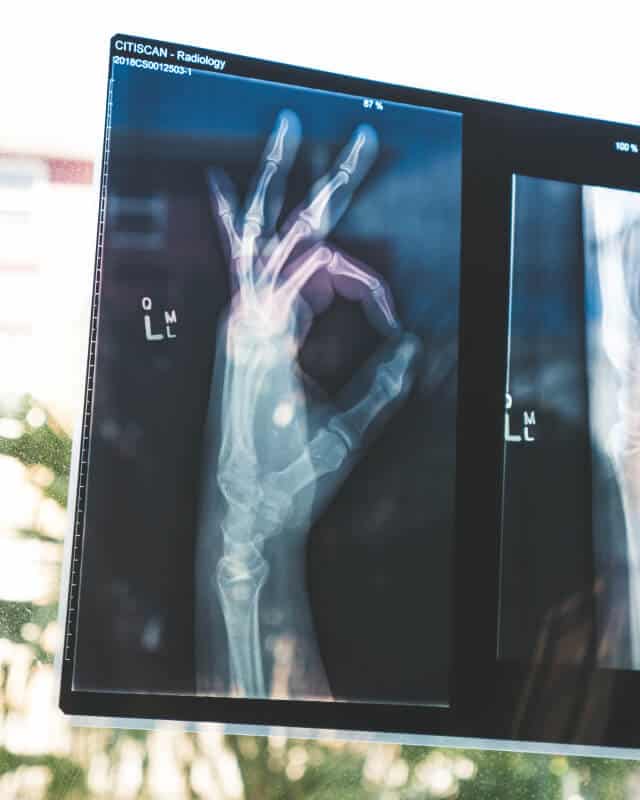
Average USMLE scores are similar between IMGs and US Grads
But Successful IMGs Have More Research Than US Grads
Next, we will look at the number of abstracts, presentations, and publications. Successful IMGs tend to have more research, as seen below. However it is not true for all specialties, and the difference isn’t as much as I expected.
| Mean number of abstracts, presentations, and publications, US Senior (Matched) | Mean number of abstracts, presentations, and publications, US IMG (Matched) | Mean number of abstracts, presentations, and publications, Non-US IMG (Matched) | |
|---|---|---|---|
| Anesthesiology | 6.6 | 5.1 | 9.1 |
| Child Neurology | 7.4 | 5.7 | 6.2 |
| Dermatology | 20.9 | N/A | 34.5 |
| Diagnostic Radiology | 8 | 7 | 16.9 |
| Emergency Medicine | 5.1 | 2.2 | 8.9 |
| Family Medicine | 4.1 | 2.3 | 3.8 |
| General Surgery | 8.6 | 5.6 | 18.5 |
| Internal Medicine | 6.9 | 2.8 | 5.8 |
| Internal Medicine/Pediatrics | 6.5 | 4.3 | 5 |
| Interventional Radiology | 12.2 | 5 | 39 |
| Neurological Surgery | 25.5 | N/A | 73.8 |
| Neurology | 7.8 | 5.7 | 10.6 |
| Obstetrics and Gynecology | 6.8 | 3.4 | 10.8 |
| Orthopaedic Surgery | 16.5 | 29.5 | 97.6 |
| Otolaryngology | 17.2 | N/A | N/A |
| Pathology | 8.5 | 5.6 | 10.5 |
| Pediatrics | 5.6 | 2.9 | 5.7 |
| Physical Medicine and Rehabilitation | 6.2 | 3.7 | 5.5 |
| Plastic Surgery | 28.4 | 19.3 | 54.3 |
| Psychiatry | 6.2 | 3.9 | 9.1 |
| Radiation Oncology | 13.3 | N/A | 17 |
| Vascular Surgery | 12.4 | N/A | 26.2 |
My takeaway? It’s certainly more challenging to get into residency as an IMG. However, if your goal is to match at a program in your given specialty, your numbers don’t have to be world-crushing.
Advice on Finding Research Positions
Want advice on finding research positions? The best place to start is your own personal network. A referral by a common contact works best. If this isn’t possible, networking while on an away rotation/observership would be my next option. (I had a student get a paid research position after doing a 1-week observership at Harvard-MGH). My last resort would be cold-emailing people. The MGH attendings told me when I was a resident that they get lots of e-mails from people asking for research positions. They ignore most of them. It’s much better to go with people you know/have met in person.
What Are the Most “IMG-Friendly” Medical Specialties?
A common question is, “what are the most IMG-friendly medical specialties?” Instead of relying on rumors, I present the data. Here is every specialty participating in the 2022 NRMP match, and what % of spots were filled by US and non-US IMGs.
| % Spots Filled by IMGs | % Spots Filled by non-US IMGs | % Spots Filled by US IMGs | |
|---|---|---|---|
| Anesthesiology | 7.9% | 3.7% | 4.2% |
| Child Neurology | 14.9% | 10.6% | 4.3% |
| Dermatology | 3.1% | 1.5% | 1.7% |
| Diagnostic Radiology | 8.5% | 5.7% | 2.8% |
| Emergency Medicine | 7.3% | 1.5% | 5.8% |
| Family Medicine | 20.6% | 7.8% | 12.9% |
| General Surgery | 9.2% | 4.6% | 4.6% |
| Internal Medicine | 35.5% | 24.8% | 10.7% |
| Internal Medicine/Pediatrics | 4.6% | 2.3% | 2.3% |
| Interventional Radiology | 2.4% | 2.4% | 0.0% |
| Neurological Surgery | 7.5% | 6.7% | 0.8% |
| Neurology | 24.8% | 18.2% | 6.5% |
| Obstetrics and Gynecology | 5.4% | 2.6% | 2.8% |
| Orthopaedic Surgery | 2.2% | 1.3% | 0.9% |
| Pathology | 40.9% | 31.4% | 9.5% |
| Pediatrics | 17.8% | 10.9% | 6.9% |
| Physical Medicine and Rehabilitation | 6.0% | 2.8% | 3.2% |
| Plastic Surgery | 5.7% | 3.6% | 2.1% |
| Psychiatry | 14.9% | 6.3% | 8.7% |
| Radiation Oncology | 11.4% | 7.0% | 4.3% |
| Vascular Surgery | 7.1% | 7.1% | 0.0% |
What Are Good USMLE Scores for IMGs?
Want to know what score you need to match into your desired specialty? Below are the average USMLE scores by specialty for the 2022 Match. Scores for both matched (successful) and unmatched (unsuccessful) IMG applicants are shown.
Average Step 1 Scores for Matched and Unmatched IMGs for 2022 Match:
| Step 1, US IMG (Matched) | Step 1, US IMG (Unmatched) | Step 1, Non-US IMG (Matched) | Step 1, Non-US IMG (Unmatched) | |
|---|---|---|---|---|
| Anesthesiology | 233 | 226 | 234 | 229 |
| Child Neurology | 227 | 215 | 228 | 218 |
| Dermatology | N/A | N/A | 251 | 239 |
| Diagnostic Radiology | 241 | 231 | 247 | 239 |
| Emergency Medicine | 227 | 213 | 231 | 222 |
| Family Medicine | 211 | 207 | 219 | 213 |
| General Surgery | 236 | 225 | 238 | 237 |
| Internal Medicine | 225 | 212 | 238 | 229 |
| Internal Medicine/Pediatrics | 220 | 215 | 230 | 228 |
| Interventional Radiology | 261 | 240 | 250 | 242 |
| Neurological Surgery | N/A | 217 | 246 | 239 |
| Neurology | 225 | 211 | 239 | 227 |
| Obstetrics and Gynecology | 226 | 217 | 236 | 230 |
| Orthopaedic Surgery | 245 | 233 | 238 | 238 |
| Otolaryngology | N/A | N/A | N/A | N/A |
| Pathology | 219 | 214 | 232 | 225 |
| Pediatrics | 220 | 209 | 229 | 219 |
| Physical Medicine and Rehabilitation | 220 | 218 | 226 | 226 |
| Plastic Surgery | 227 | 231 | 224 | 218 |
| Psychiatry | 216 | 211 | 229 | 217 |
| Radiation Oncology | N/A | N/A | 228 | 218 |
| Vascular Surgery | N/A | N/A | 241 | 242 |
Average Step 2 Scores for Matched and Unmatched IMGs for 2022 Match:
| Step 2, US IMG (Matched) | Step 2, US IMG (Unmatched) | Step 2, Non-US IMG (Matched) | Step 2, Non-US IMG (Unmatched) | |
|---|---|---|---|---|
| Anesthesiology | 240 | 236 | 243 | 239 |
| Child Neurology | 234 | 225 | 239 | 226 |
| Dermatology | N/S | N/A | 252 | 241 |
| Diagnostic Radiology | 247 | 239 | 250 | 245 |
| Emergency Medicine | 238 | 225 | 240 | 233 |
| Family Medicine | 225 | 219 | 231 | 224 |
| General Surgery | 246 | 234 | 247 | 244 |
| Internal Medicine | 235 | 222 | 245 | 236 |
| Internal Medicine/Pediatrics | 229 | 231 | 243 | 239 |
| Interventional Radiology | 270 | 244 | 246 | 243 |
| Neurological Surgery | N/A | 228 | 247 | 240 |
| Neurology | 235 | 225 | 245 | 233 |
| Obstetrics and Gynecology | 243 | 232 | 243 | 236 |
| Orthopaedic Surgery | 255 | 241 | 249 | 242 |
| Otolaryngology | N/A | N/A | N/A | N/A |
| Pathology | 228 | 221 | 238 | 230 |
| Pediatrics | 233 | 221 | 240 | 230 |
| Physical Medicine and Rehabilitation | 227 | 229 | 237 | 228 |
| Plastic Surgery | 232 | 244 | 240 | 234 |
| Psychiatry | 228 | 222 | 236 | 227 |
| Radiation Oncology | N/A | N/A | 240 | 224 |
| Vascular Surgery | 251 | 247 |
Next, we will discuss the steps you need to take to gain admission to residency in the United States. We’ll start by examining ECFMG certification.
Why Do I Need ECFMG Certification?
If you want to do residency or fellowship in the United States, you need ECFMG certification. The Educational Commission for Foreign Medical Graduates sets the standard for evaluating an IMG’s qualifications before they enter US graduate medical education.
Who is Eligible to Apply for ECFMG Certification?
The ECFMG certifies students from many, but not all, international medical schools. Want to check to see if you are eligible to apply for ECFMG certification? Find your school in the “World Directory of Medical Schools.” There, you can verify if your school’s graduates are eligible for ECFMG certification. Go to the World Directory of Medical Schools to see if your school meets ECFMG eligibility requirements. Note, that in 2024, the ECFMG will require medical schools to be accredited. Per ECFMG Website:
Important Note: Starting in 2024, individuals applying for ECFMG Certification must be a student or graduate of a medical school that is appropriately accredited. More specifically, the school must be accredited by an accrediting agency that is officially recognized by the World Federation for Medical Education (WFME). The WFME Recognition Programme is the only program accepted by ECFMG at the current time for the recognition of medical school accrediting agencies. Thus, beginning in 2024, medical schools will need to be accredited by a WFME-recognized accrediting agency if they wish to ensure their students and graduates are eligible for ECFMG Certification.
Basic Outline to Get ECFMG Certification
In general terms, there are three things you need for ECFMG certification:
- Pass the USMLEs: Pass Step 1, Step 2 CK
- Complete an ECFMG pathway which includes a passing score on the Occupational English Test (OET) for Medicine
- Have graduated from an ECFMG-approved medical school, and have it verified
Note that applying for ECFMG certification is NOT the same as being certified. For example, before you can take the USMLEs, you need to apply for ECFMG certification. However, before receiving the ECFMG certificate, you must pass USMLE Step 1, Step 2 CK. (Confused? See table below for clarification).
Steps for ECFMG Certification
I will outline the necessary steps for ECFMG certification below. For more information, please visit the ECFMG website.
- Apply for a USMLE/ECFMG ID.
- Submit an application for ECFMG certification. Note: this merely begins the process of ECFMG certification (see requirements above).
- Verify status as current student/graduate. The ECFMG must verify with your medical school that you are attending/have graduated. Verification is either electronic through the ECFMG Medical School Web Portal (EMSWP) Status Verification program or via a paper form (Certification Statement Form 183). Note: students report this can take anywhere from 1-4+ months. You must begin this process early, as you cannot take the USMLEs before verifying your student status.
- Graduate from med school. You must confirm graduating from your medical school and receipt of your diploma.
- Apply to take the USMLEs. Once you have your ECFMG ID and have applied for ECFMG certification, you can sign up and apply for the USMLE exams.
- Pass all required USMLEs (Step 1, Step 2 CK).
- Apply through the appropriate ECFMG Pathway (unless you have a passing score on the former Step 2 CS component).
Do I Need to Be ECFMG Certified to Apply for Residency/Participate in the Match?
This is a common point of confusion. You do NOT need to be certified by the time you apply for residency. However, you do need to have the complete ECFMG certification before you start residency. Here is an excerpt from the ECFMG Certification Factsheet:
“You must be certified by ECFMG before your program’s start date, although you can apply to programs before becoming certified.”
You also do NOT need to be certified to participate in the Match. (Although you DO need passing scores for Step 1 and Step 2 CK). To learn more about ECFMG certification, see the ECFMG website.
What is Required to…?
Are you thoroughly confused? Does this feel like a meaningless jumble of letters/words? Here is a table with various relevant requirements.
| USMLE/ECFMG ID | Passing score on Step 1, Step 2 CK, Step 2 CS | Apply to ECFMG Pathway | ECFMG Certification | |
|---|---|---|---|---|
| Apply to take Step 1, Step 2 CK, Step 2 CS | x | |||
| Apply for ECFMG certification (i.e. begin the process) | x | |||
| Submit an application for residency | x | |||
| Submit a Match list / participate in the NRMP "Match" | x | x | x | |
| Go to an ACGME-accredited residency/fellowship | x | x | x | x |
| Register/Take USMLE Step 3 | x | x | x | x |
What is the Big-Picture Timeline of the Residency Application Process?
This is a list of the most important dates to remember for residency applications, for Match 2023. Note that applications begin the year prior for a given Match year. Thus, to participate in the 2023 Match, you would submit your application during September of 2022. You would then begin residency summer of 2023 (typically June or July).
- September 15 (date usually fixed): Can begin submitting residency applications. (Most interview offers are on a rolling basis. It is highly recommended to submit your applications on the first day possible).
- October 1: MSPE (formerly Dean’s Letter) released to residency programs. Typically programs begin sending out interview requests starting Oct 1.
- October – January: applicants interview at residency programs
- January 31: registration closes
- February 1: can begin submitting a rank list
- March 1: Rank order list certification deadline
- March 13 (date variable, but usually around Mid-March ): Match Day!
When Should an IMG Plan to Complete Their USMLEs?
When should an IMG plan to take the USMLEs, so their residency application doesn’t get delayed? The short answer: take all your USMLE exams as early as you can while still achieving good scores. A conservative recommendation? Have all USMLE scores (Step 1, Step 2 CK) available and your Pathway application sent in before submitting your residency application. For ECFMG certification, you need passing scores on USMLE Step 1 and Step 2 CK . You also need passing Step 1 and Step 2 CK scores before you certify your rank order list. (Due date: usually around the end of February/beginning of March- check the NRMP calendar, as this date varies slightly from year to year. This allows you to participate in the NRMP Match). However, most residency programs look closely at your USMLE scores. As we saw above, attaining a US residency spot as an IMG is highly competitive. As such, I recommend having Step 1 and Step 2 CK scores available before submitting your residency application.
When Should You Take Step 1 or Step 2 CK to Have Your Scores in Time?
The NBME typically reports USMLE Step 1 and Step 2 CK scores within 4 weeks of taking the exam. As such, the latest you should take Step 1 and Step 2 CK would be 1 month before applying for residency. (Remember, you should submit your application on September 15.) However, delays in score reporting can occur when the NBME modifies the test format. As such, you should check usmle.org for announcements.
When Should You Apply for an ECFMG Pathway?
Ideally, you would have a Pathway application completed before September 15 (the first day you can submit residency applications). This would ensure you have ample time for delays in the paperwork and verification process. However, the latest you are can submit your ECFMG Pathway application is January 31 of the Match year. ECFMG needs to determine the outcome of your Pathways application before it can determine your eligibility for the Match. Be aware that once you start your Pathways application, you have to hand in all documentation by January 31. If you don’t have all of the paperwork completed, your Pathways application will be rejected, and you will have to reapply the following Match year (including having to repay all of the fees). So make sure to start your Pathways application early and submit before January 31.
How Long Are Your USMLE Results Good for?
For ECFMG certification purposes, you have 7 years to pass all Step 1 and Step 2 CK and compete a Pathway. (Remember, Step 3 isn’t required for ECFMG certification). Per the ECFMG:
ECFMG policy requires that international medical students/graduates pass the USMLE Steps and Step Components required for ECFMG Certification within a seven-year period. This means that once you pass a Step or Step Component, you will have seven years to pass all of the other Step(s) or Step Component(s) required for ECFMG Certification. This seven-year period begins on the exam date of the first Step or Step Component passed and ends exactly seven years from that exam date.
In other words, let’s say you pass Step 1 on October 1, 2015. You have through October 1, 2022, to take and pass Step 2 CK and complete a Pathway application. If you don’t do so, your passing score on Step 1 will no longer be valid for ECFMG certification.
Summary of USMLE Recommendations/Deadlines
The ideal time to take:
- USMLE Step 1: before August of the year before desired Match Year
- Step 2 CK: before August of the year before desired Match Year
Required time to take exams to participate in Match:
- USMLE Step 1: before August of the year before desired Match Year. (Your application will almost certainly be ignored without a Step 1 score).
- Step 2 CK: technically, you’d have to take it before January of your desired Match year. However, it’s recommended you have your Step 2 CK score available by the time you apply for residency.
- Must pass both exams in a 7-year time period for ECFMG certification.
Clerkships vs. Observerships: The Basics
Typical advice is for IMGs to have at least 1-3 months of clinical experience in the US before applying to residency. Why? Program directors want to see that you are familiar with the system. It is rare to see IMGs admitted to a US residency without experience in an American hospital. However, this experience varies dramatically. The most considerable difference is the kind of experience. A “clerkship” is what 3rd and 4th year US medical students do. You are a part of the team, and can participate in the direct clinical care of patients. You typically would write notes, give presentations on rounds, and otherwise be a part of a care team. An “observership” is strictly shadowing. You would observe an attending/care team. The general rule is that you would not participate in the clinical care of patients (e.g. patient notes, presentations, etc.).
Generally, Only Med Students Can Do Clerkships
Rules vary from institution to institution. The most important thing to note is that most hospitals only allow current medical students to participate in clerkships. In other words, if you graduated from medical school, you likely will only be able to do an observership. Why? Supposedly it is due to concern for malpractice. The upshot? If you are a current medical student, see if your school supports clerkships abroad to the US. This is by far the best way to gain clinical experience. Not only will you have hands-on experience in the US system. But you will also have a better chance to impress attendings. (Remember, most programs require at least 3 letters of recommendation, which are very important to program directors). Note: you may have read about “externships,” for IMGs who have graduated already. From what I can gather, these are like clerkships. You do work for the hospital. However, you don’t get paid or receive credit with your medical school. While they sound great, I have never actually heard of someone doing an externship. (If you have experience with externships, please let us know in the comments!).
US IMG vs. Non-US IMG
It is critical to understand the difference between US IMGs vs. Non-US IMGs. Non-US IMGs need visa sponsorship for any US graduate medical education (e.g., residency). US IMGs do not (they already have the legal right to stay in the United States). Visa sponsorship presents a challenge to residency programs. It may be an extra administrative burden, with additional cost, for the residency program. Take Family Medicine (FM) for example. Only a subset of FM programs will consider giving an interview to a candidate who requires visa sponsorship. Others will not. In a 2020 survey of program directors, 28% said they considered “visa status” when offering interviews. For non-US IMGs, that means fewer residency programs available to you. Also, some residencies may discriminate against particular regions like the Caribbean. So while they might say they are open to “IMGs,” there is a chance that you are not the “right IMG” for their program. Example: A residency is open to offering a spot to a candidate from Oxford or Cambridge. However, they will not consider any candidates from the Caribbean.
How to Create a List of “IMG-Friendly” Programs in ≤ 5 minutes
My advice? Compile your own list of acceptable programs. Begin with a directory that has all the available residency programs. You can use the ACGME directory, FREIDA, or the Residency Explorer Tool. Personally, I find the Residency Explorer Tool the most useful. (Click here to read FREIDA: The “Residency/Fellowship Search Engine” You’ve Been Looking For or here to read Residency Explorer – Use This for a Successful Match) On the Residency Explorer, you can refine your search by state and specialty. Even better, you can sort for programs that offer J1 or H1-B visas (see below).
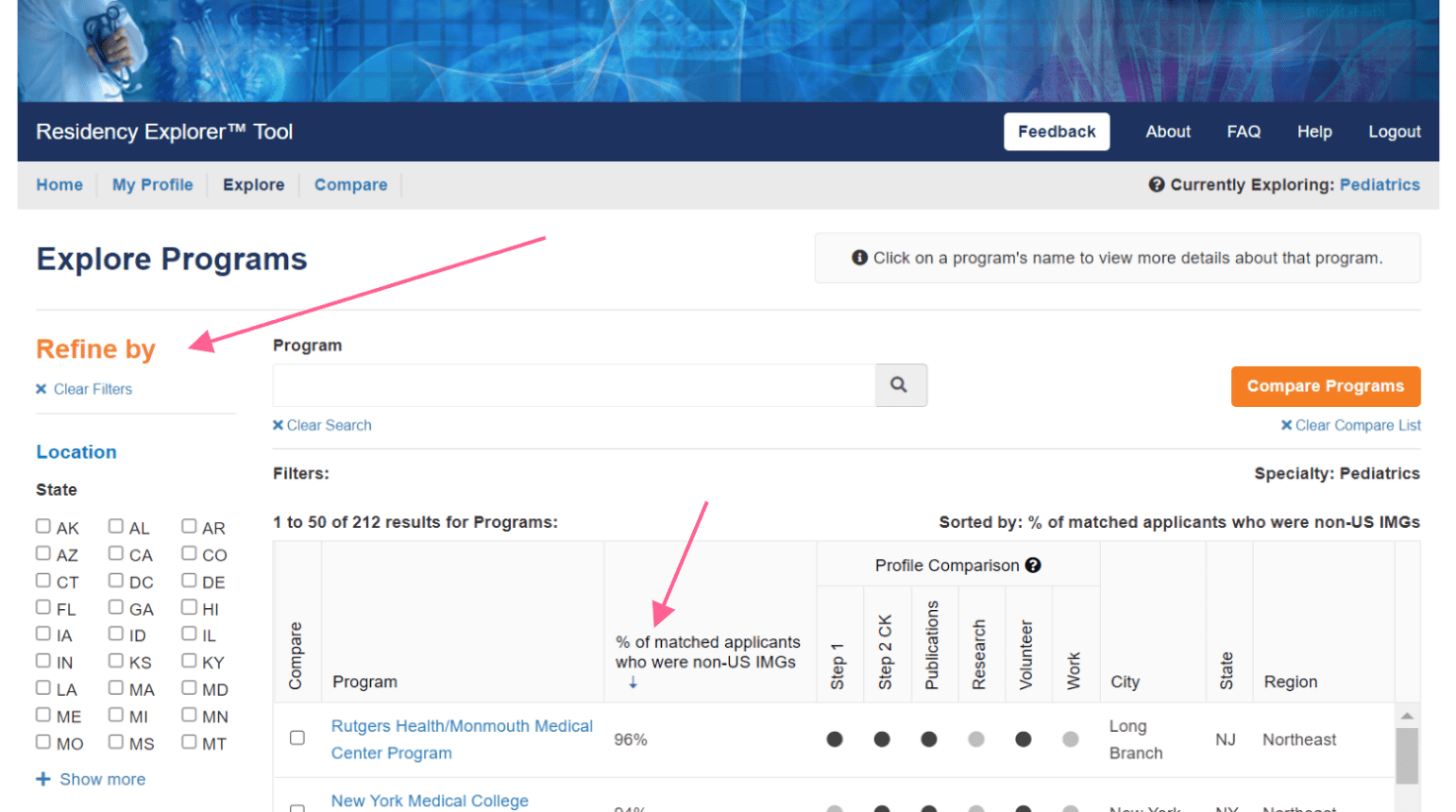
The Residency Explorer Has Many Useful Filter Options.
Then, you can sort the program list by % of applicants with your status, whether you are a US senior, US IMG, or Non-US IMG (as shown above).
Compare Programs for Key Statistics
This is an effective way to generate a quick list. Next, you can see these programs in the context of your application’s competitiveness (Scores, letters, publications, etc.). You can use the “Compare Programs” tool to see quick stats, like # of residents, average hours/week, % of IMG residents, etc.
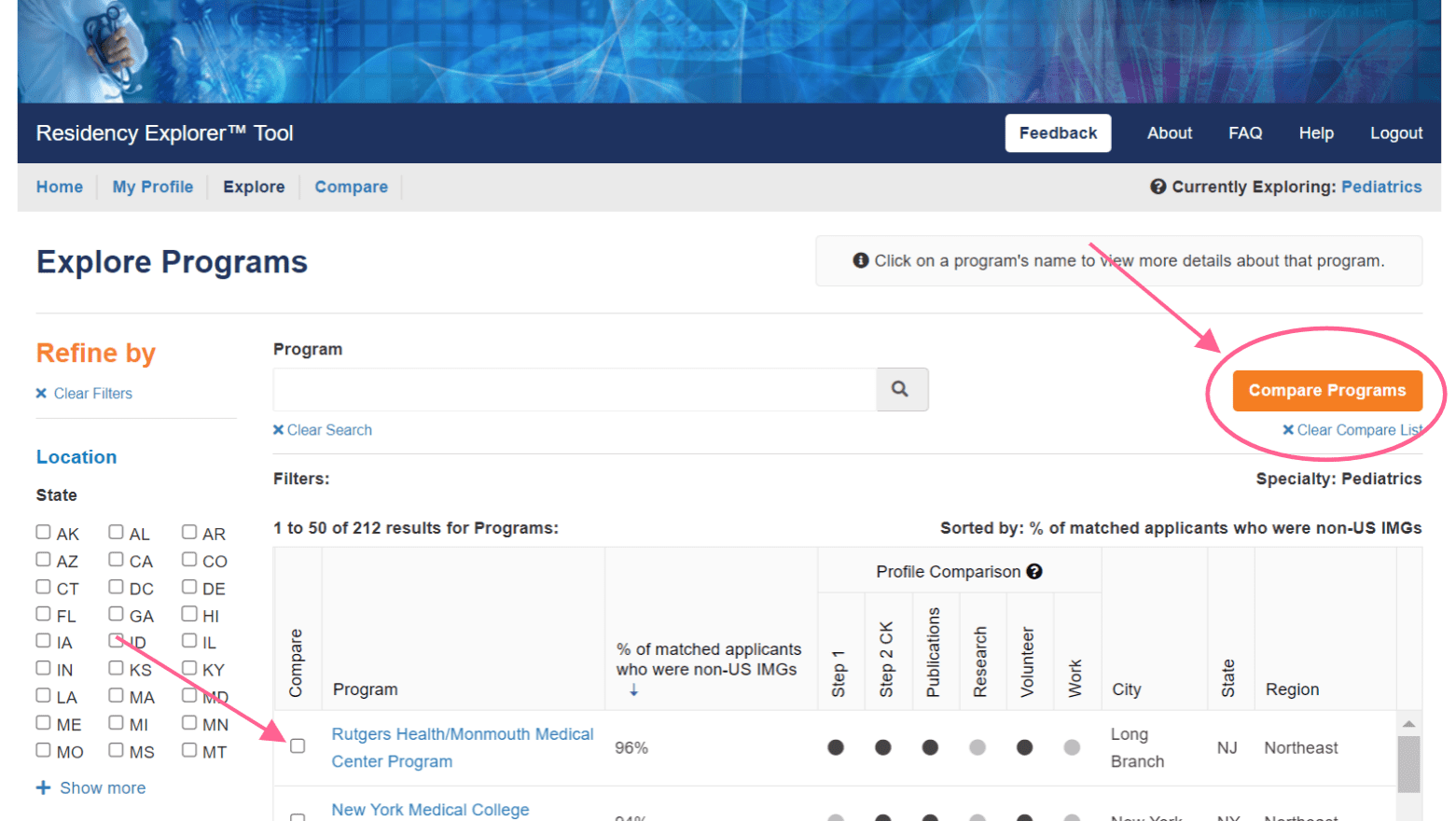
You can add as many programs as you want to the comparison list.

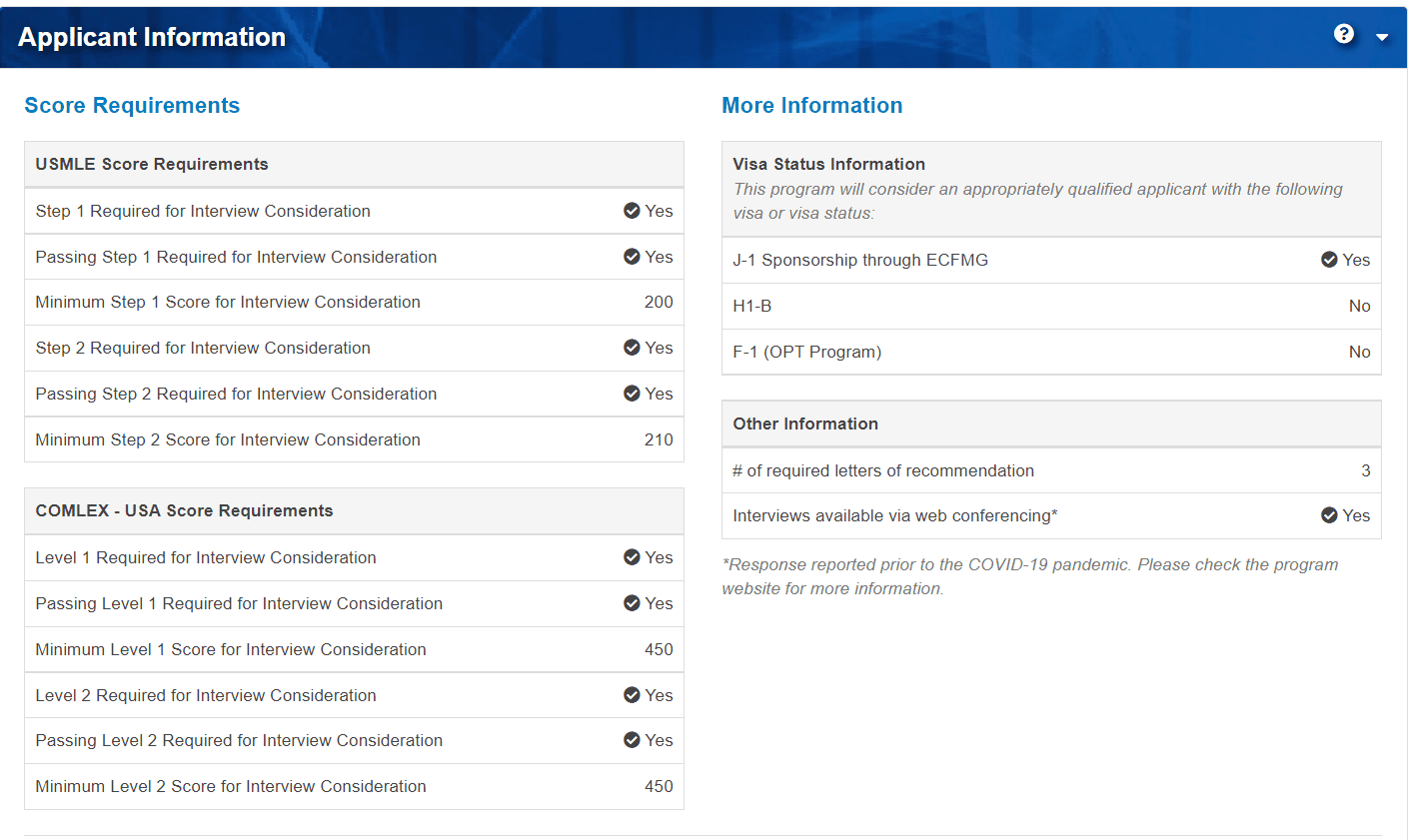
The Sinai Hospital of Baltimore Program sponsors J-1 visas and lists USMLE cut-offs for interview consideration.
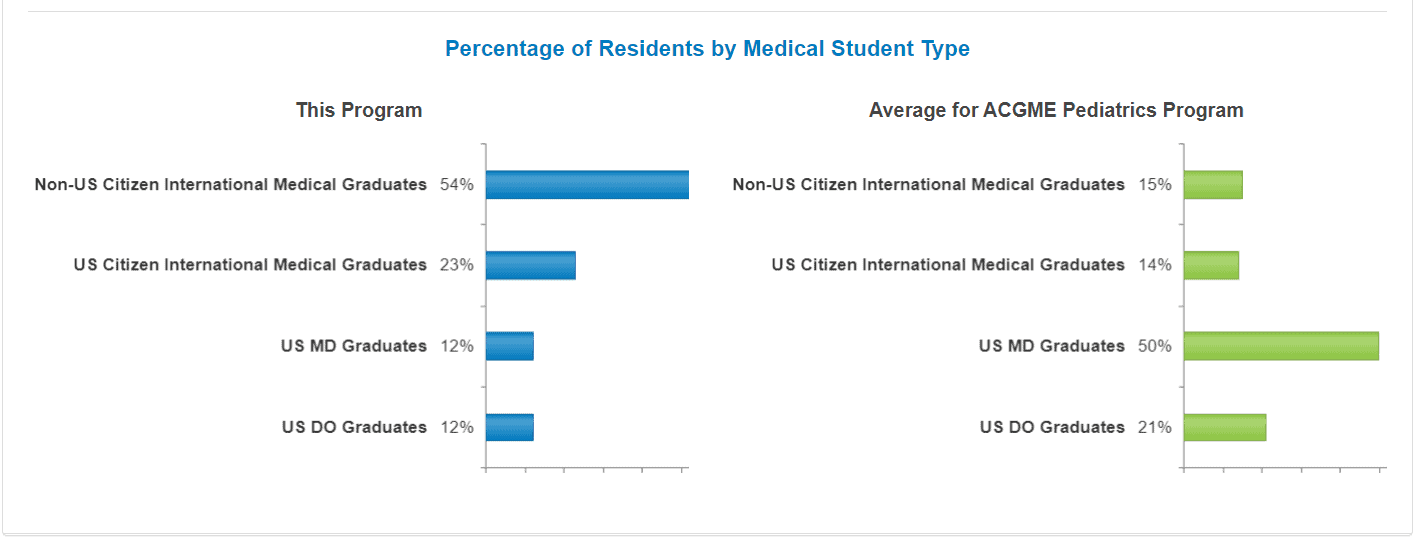
Their resident population is made up of more IMGS than US graduates…A very IMG-friendly program.
Non-US IMGs and the Visa
For this section on Visas, I enlisted a former student, “Grateful Student.” He attends a Caribbean med school, and is a non-US IMG. Legal disclaimer: we are not lawyers. This post should not be considered legal advice. You should seek appropriate counsel for your own situation, including if you are seeking a visa or other legal status. Here is “Grateful Student”: There are two types of visa one can pursue graduate medical education in the US. There is the “J1” (“Exchange Visitor”) and the “H1-B” (“Temporary Work”). The J1 is known as the exchange visitor visa. Basically, it means that you will be allowed to come to the US for the duration of your training (ex: 3 years for FM). You must then return to your home country for a minimum period of 2 years. After these 2 years, you can apply to immigrate back to the US as a physician. The H1-B is the temporary work visa. It will allow you to stay in the US for the duration of your training. It does not have the requirement of going back home for two years. As long as you get a job after your residency, you can stay in the US and work towards a green card or even citizenship. The H1-B sounds like a great deal, and it is! However, most residency programs will sponsor J1s only. A fraction sponsor H1-Bs. (For example, of the 602 programs on FREIDA in 2022, 421 IM programs stated they sponsored J1 visas. However, only 135 sponsored H1-B visas.) Why? One reason is that the ECFMG sponsors the J1 visa. As such, it does not place an onus on the residency programs except for filling out and certifying forms.
Why H1-Bs are Harder to Find
The H1-B is more difficult for residency programs. It requires a lawyer to fill out forms. Additionally, the residency must reportedly prove they could not get a qualified US citizen to fill that job. The programs also need to pay more money to sponsor the H1-B visa. Because of this difference, most residency programs only sponsor the J1. Another caveat to keep in mind is that to get the H1-B, you will need to be fully certified and have passed Step 3. Being eligible to take Step 3 requires you to have the complete ECMFG certification. (Read: you have to have graduated and completed Step 1, CK, and an ECFMG Pathway). This extra Step 3 requirement can be a big challenge. This is especially true if you are graduating in the spring of the year you will start residency! A final note: the J1 visa lasts up to 7 years. The H1-B lasts only 6 years. Depending on the length of your planned training, including fellowship, you may need to apply for an extension. Also note H1-Bs are assigned via “lottery” – not everyone that applies will receive one.
J1 Waivers Allow You to Stay in the US
There is a process one can use to get a waiver of the two-year return to your country requirement. It typically entails working in an “underserved area” in the US for three years. After which, you can then start the process of becoming a US citizen. Please note, these waivers are not guaranteed. There are many restrictions on them, and they are limited in quantity. For example, they are usually in primary care and may require you to move to a different part of the country. So if you finished a residency that doesn’t qualify as “primary care” then there is a good chance you won’t be eligible for the J1 waiver. In that case, you would have to return to your home country for at least two years.
Inspiration: Other Successful IMGs
I’ve worked with a large number of IMGs, many of whom successfully went on to residency in the US. The issues they face are often different from those of US Seniors. You can read more of their experiences below:
- How this Caribbean IMG Got Her Top Choice “ROAD” Residency
- USMLE Step 1 207 to 241 in 4 weeks
- From 136 to Step 1 247: Conquer Memorization for Impressive Boards Scores
Further Resources
Residency Explorer Tool: search source-verified information from US residencies/fellowships for criteria such as visa sponsorship, % IMGs, etc. FREIDA: search self-reported surveys from US residencies/fellowships for criteria such as visa sponsorship, % of IMGs in residency classes. ECFMG Website: information from the body that will “certify” you and allow you to attend residency in the US. Charting Outcomes in the Match: actual data from the NRMP on successful residency applicants, including IMGs. USCIS Website: US Citizens and Immigration Services website, with information on visas, J-1 waivers, and much more.
Concluding Thoughts
The process of obtaining residency in the US can be overwhelming. The rumors, misinformation, and hysteria are deafening. The decision of whether to train in the US – and your medical specialty – have lifelong consequences. My goal with this guide is to provide data, advice, and perspective so you can make the best decisions. If this guide has helped you, please share it with others!
What do you think? Does being an IMG seem as hard as before? Let us know in the comments!
Sources: National Resident Matching Program, Charting Outcomes in the Match: International Medical Graduates, 2022. National Resident Matching Program, Washington, DC 2022. National Resident Matching Program, Charting Outcomes in the Match: U.S. Allopathic Seniors, 2022. National Resident Matching Program, Washington, DC 2022. National Resident Matching Program, Data Release and Research Committee: Results of the 2020 NRMP Program Director Survey. National Resident Matching Program, Washington, DC. 2020.

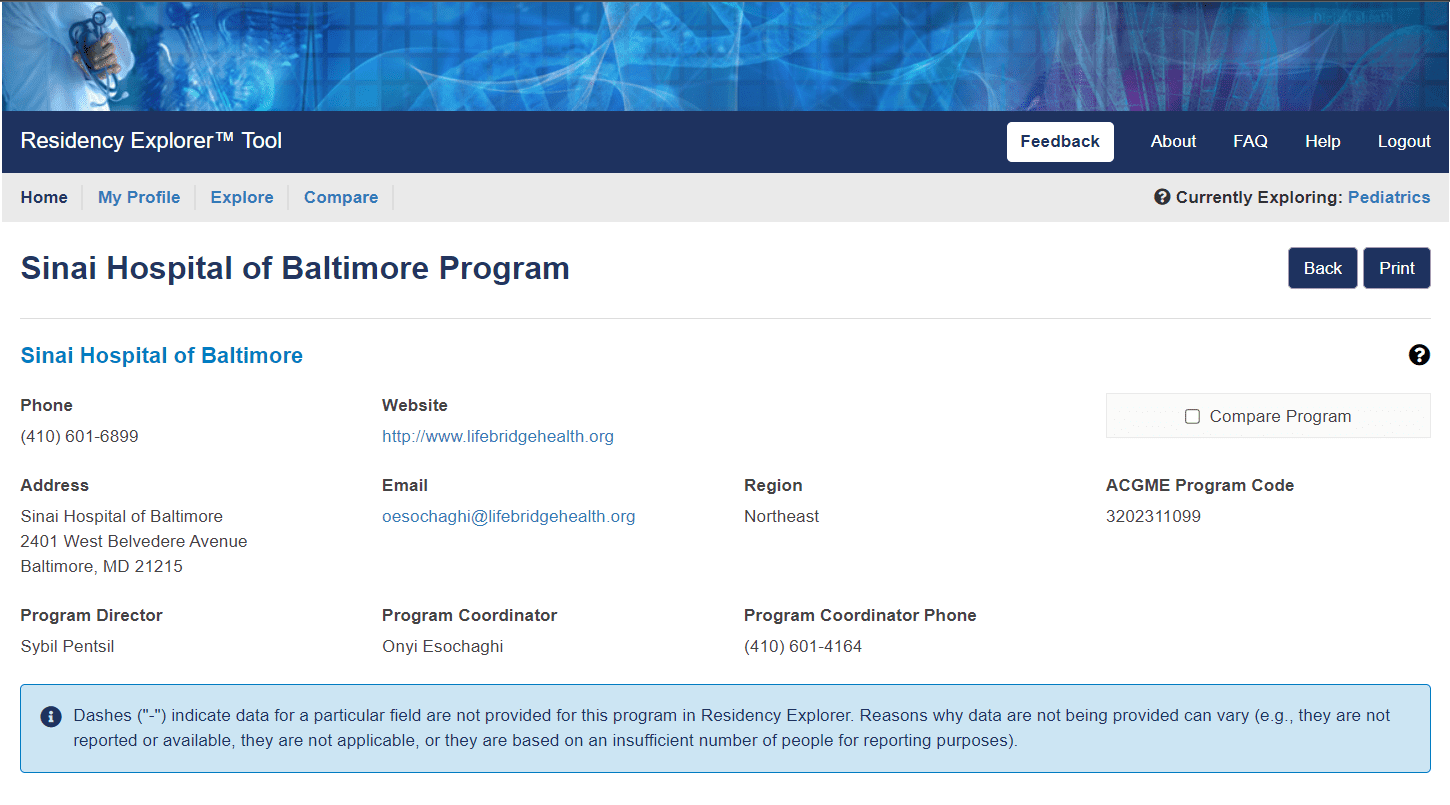







Hi, thank you for an amazing post. It helps a lot. I wanted to tell you, that I am a Non-US IMG and I did externship in the USA. I also wanted to ask, how can I inform ECFMG that I’ve already graduate ?
Hi Dominika – thanks for your question. I assume that you can reach out to the ECFMG directly to communicate that to them, as I’m sure there are many people in your situation of having graduated already.
Dr. Palmerton
Hi Alec, thank you for such an informative post.
Is it necessary to have written and passed the step 3 before applying to a program to be considered for a H1B Visa?
Hi!
Thank you for a great page – it’s by far the best summary of information related to IMGs I’ve come across so far. I am currently studying at a Swedish med.school, while also doing my best to prepare for applying to general surgery residencies in the US. My USMLE scores are high, I’ve done part-time research since first year (and been published a couple of times), and I’m combining my M.D with a M.S in public health. I’ve spent last two summers going abroad to take clinical rotations related to surgery, and will do so again as an exchange at Harvard, so by the time I graduate I will have some experience and hopefully also good recommendations from US doctors.
Now, to my problem. I probably won’t be able to go to the US for interviews while still being in medical school, since that would cause me to miss important rotations during my final semester (our program ends late December). My plan is therefore to take one year after med school to submitt my residency application. Do you have any suggestions of what I should do during that year? Do an externships in the US? Continue doing medical research in Sweden (which I’m currently doing part-time)? Work as a PGY1-intern in Sweden? Take another master’s degree? I would like to do something that enhances my possibilities of getting a residency, rather than doing something that will meke it look like I took a year of doing nothing of value.. I would greatly appreciate your advice on this matter!
Hi Alec
I am a non-US IMG and I want to enter an internal medicine residency program.
Got 247 on step 1 and 245 on ck. As usually people with my score on step 1 get >250 on step 2 ck, will my grade affect greatly my chances of entering a good residency program (mid tier program)?
Your article mentioned ECFMG consider IMG ppl who study outside of US or Canada. Do program directors consider graduates from a Canadian medical school IMG?
Hi, alec i have a question…. I finish my internship the 31th december ;so newly i would get diploma , and application for match starts at september, my concern is that if i can send my documents to eras in january and have chance to match ,eveantually i would have passed my step 1 and 2
Submitting an application in January would not be a good idea, since most places will already be nearly done with their interviews. I can’t know for certain without working with your directly, but that would be my first impression. Especially if you haven’t passed Step 1/Step 2 CK yet, I’d recommend waiting for the next cycle, to prepare properly and get better USMLE scores and have a stronger application.
Alec
Hi Alex,
Thanks for the useful info, and I was wondering if you have statistics that shows which medical school IMG’s or which country IMG’s are scoring higher results in USMLE ?
Hi Alex!
I am a US citizen attending a US med school, but my girlfriend is Canadian. She went to a school in the Caribbean so I guess she would be classified as a non-US IMG. We want to get married next year as we have been together for 7 years now, and she would be applying and obtaining her greencard prior to the match. So would she still be classified as a non-US IMG, or as a US IMG since she has her greencard? I ask because her step score is below average for the field she wishes to pursue (internal medicine), but above average if she were to be categorized as a US-IMG…so we are deciding now which speciality would be safer for her.
Thanks,
Caleb
Hello Alex!
I was just reading this article about the possible changes to the USMLE scoring system. I have to say I am a bit concerned of how that would potentially change the whole match process especially for us IMG, who might not have been to the most prestigious medical schools. USMLE step 1 score has been considered the most important factor or the least to say that it plays a major role in selection process . I am wondering what other factors would be of greater Value if USMLE would be a pass/fail exam? Would this change make the matching process even more harder and competitive?
Hi Alec! Thank you for the super informative article! I’m an IMG currently in finaly year of med school in Australia.
The intern recruitment procedures for 2020 Jan has started here and I’ve been thinking about some practical issues. I plan on not doing the intern year here and instead spending the year doing things that will increase my chances at matching in the US.
Currently, I have not taken any of the USMLE steps (have been studying) and do not have any research publications/abstract in the field I am interested in (anaesthesiology or IM). Next year, in preparation for the 2021 Match, I would like to do some part time research work in the US while also doing US clinical experience and studying for the USMLE next year.
The issue with that is, I am not sure what I can do regarding visa. I don’t have a greencard, and all I have really is the 3 month visitor visa. I assume most research involvement will last longer than 3 months, and research labs/ hospitals would not typically not sponsor a non-full time employee (let alone a non-paid volunteer) a visa.
I was wondering what you have seen over the years working with IMGs, and if you had any advice/thoughts on this? Thank you so much!
Hi! My current stats are: Non-US IMG
Finished Internal Medicine residency in Philippines 2022
Graduated Medical School: 2018
Research: 1-2
US clinical experience: 0
(probably almost the same with Agnes Park…5 years ago 🙂
Goal: US neurology residency
I was wondering if i could also do a simultaneous research position and clinical experience?
thank you!
Many thanks for providing us with this article. It is an eye-opening for the journey ahead.
Please do you have information on the SF match and Ophthalmology programs?